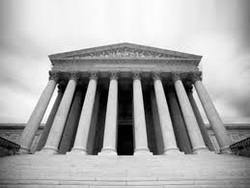
“She only got in because she’s black.”
Admit it, you’ve either thought of it in your head, said it aloud or heard it from someone else. It has become an idea that permeates through the college admissions process. And as the Supreme Court looks to review the concept of Affirmative Action in admissions this fall, the “race card” has once again captured the national spotlight.
Fischer vs. The University of Texas will once again regenerate the Affirmative Action debate. The case involves Abigail Fischer, a Caucasian student currently in Louisiana State University, who is challenging the university’s admission process.
The state of Texas currently uses the “Top 10 percent rule” as apart of its admission process, in which the top high school students within the 10 percent margin are guaranteed admission to all public Texas universities. Those who don’t qualify then apply through a regular admissions process.
Abigail Fischer applied to the University of Texas with a 3.59 GPA and an SAT score of 1180, yet wasn’t eligible for the rule as she wasn’t within the 10 percent range. Like many, she found herself applying through the standard admissions process and found herself rejected.
She cites that the university had favored minorities after accepting the top 10 percent, since the UT policy uses race as a factor in choosing applicants.
But, it seems to me that Fischer is just finding an excuse for her rejection. As she finds herself rejected, the scapegoat: the black student who worked hard throughout their high school career, seems to be the only clear reason for why.
Let’s start off with a history lesson. Affirmative Action is a set of policies that were created to eliminate the effects of past discrimination through either race, religion, sex, or national origin. One of these policies allows colleges to use race as a factor in college admissions, meaning a minority student has a small advantage when applying for college.
A heated topic that has created ongoing debates, the Supreme Court has reviewed multiple cases concerning this provision of Affirmative Action. Today, based on previous precedents, including the infamous Gratz vs. Bollinger court case in 2003, the Supreme Court has ruled that colleges may use race as one of many factors that determine a student’s admission. However, a student can’t be granted “extra points” simply because of his race nor can a school assign a set amount of students to be filled by minorities. And this fall the Supreme Court will once again take on the issue of race concerning university admissions in Fischer vs. The University of Texas.
Reality check Ms. Fischer: what makes you so sure race was the only factor that impeded your admissions? How can you be sure to pin-point your personal rejection on affirmative action? Why not blame the legacy students? The poor students? The extraordinary students? The list goes on.
Unfortunately, many fail to see that necessity Affirmative Action. To get rid of it completely would be an ignorant and naïve move which suggests that racism is no longer an issue in American society; which is an oxymoron in itself, as this issue highlights the existence of racism today. As much as many try to avoid the idea, racial discrimination is still a major force in American society. Not to say that we are in the same state as were 50 years ago, or ignore the strides of progress that have been made. But, to declare it non-existent or having played no effect on society today is simply ill-bred.
Especially when statistics shows that an African American is three times more likely to live in poverty than a Caucasian child, and the National Center of Education reports that African Americans and Latinos are more likely to attend high poverty schools. A large pool of minority students seem to be steps behind in the academic race to college, add malfunctioning schools, and a lack of resources. It seems unfair to compare them to a student whose parents enrolled them into after-school tutoring, SAT Prep classes, and successful schools. Which is why the one key improvement to Affirmative Action is to factor in socio-economic background. We can’t categorize one race to fit statistics, trust me I understand that complexity.
What really doesn’t make sense is how many seem to overlook other so-called unfair disadvantages in the college admissions process, specifically legacy-admissions. It is common knowledge that a student with alumns as relatives have a larger probability of acceptance into that school, a probability that nearly doubles-solely on the basis of your family. At Harvard University, the legacy acceptance rate is a whopping thirty percent, more than four times the regular admissions rate according to The Crimson. Interestingly, Yale University noticed a large correlation between alumni donations and legacy-admissions. Meaning rich have a larger unconsecrated advantage, one that is largely overlooked.
Oh, and Ms. Fischer, Texas A&M has one of the biggest legacy programs in the country, according to the Houston Chronicles.
In the end, colleges there are many injustices that occur in the depths of the college admissions office. No doubt about it. But to blame a certain set of students because of your rejection is unfair and quite frankly, pretentious, if you’re not blaming everyone. Colleges don’t simply look at your skin color, your gender, you ethnicity and admit you in simply because they’re in need or because policies tell them to. So the next time you think a black kid got in because of their race, think again.
Admit it, you’ve either thought of it in your head, said it aloud or heard it from someone else. It has become an idea that permeates through the college admissions process. And as the Supreme Court looks to review the concept of Affirmative Action in admissions this fall, the “race card” has once again captured the national spotlight.
Fischer vs. The University of Texas will once again regenerate the Affirmative Action debate. The case involves Abigail Fischer, a Caucasian student currently in Louisiana State University, who is challenging the university’s admission process.
The state of Texas currently uses the “Top 10 percent rule” as apart of its admission process, in which the top high school students within the 10 percent margin are guaranteed admission to all public Texas universities. Those who don’t qualify then apply through a regular admissions process.
Abigail Fischer applied to the University of Texas with a 3.59 GPA and an SAT score of 1180, yet wasn’t eligible for the rule as she wasn’t within the 10 percent range. Like many, she found herself applying through the standard admissions process and found herself rejected.
She cites that the university had favored minorities after accepting the top 10 percent, since the UT policy uses race as a factor in choosing applicants.
But, it seems to me that Fischer is just finding an excuse for her rejection. As she finds herself rejected, the scapegoat: the black student who worked hard throughout their high school career, seems to be the only clear reason for why.
Let’s start off with a history lesson. Affirmative Action is a set of policies that were created to eliminate the effects of past discrimination through either race, religion, sex, or national origin. One of these policies allows colleges to use race as a factor in college admissions, meaning a minority student has a small advantage when applying for college.
A heated topic that has created ongoing debates, the Supreme Court has reviewed multiple cases concerning this provision of Affirmative Action. Today, based on previous precedents, including the infamous Gratz vs. Bollinger court case in 2003, the Supreme Court has ruled that colleges may use race as one of many factors that determine a student’s admission. However, a student can’t be granted “extra points” simply because of his race nor can a school assign a set amount of students to be filled by minorities. And this fall the Supreme Court will once again take on the issue of race concerning university admissions in Fischer vs. The University of Texas.
Reality check Ms. Fischer: what makes you so sure race was the only factor that impeded your admissions? How can you be sure to pin-point your personal rejection on affirmative action? Why not blame the legacy students? The poor students? The extraordinary students? The list goes on.
Unfortunately, many fail to see that necessity Affirmative Action. To get rid of it completely would be an ignorant and naïve move which suggests that racism is no longer an issue in American society; which is an oxymoron in itself, as this issue highlights the existence of racism today. As much as many try to avoid the idea, racial discrimination is still a major force in American society. Not to say that we are in the same state as were 50 years ago, or ignore the strides of progress that have been made. But, to declare it non-existent or having played no effect on society today is simply ill-bred.
Especially when statistics shows that an African American is three times more likely to live in poverty than a Caucasian child, and the National Center of Education reports that African Americans and Latinos are more likely to attend high poverty schools. A large pool of minority students seem to be steps behind in the academic race to college, add malfunctioning schools, and a lack of resources. It seems unfair to compare them to a student whose parents enrolled them into after-school tutoring, SAT Prep classes, and successful schools. Which is why the one key improvement to Affirmative Action is to factor in socio-economic background. We can’t categorize one race to fit statistics, trust me I understand that complexity.
What really doesn’t make sense is how many seem to overlook other so-called unfair disadvantages in the college admissions process, specifically legacy-admissions. It is common knowledge that a student with alumns as relatives have a larger probability of acceptance into that school, a probability that nearly doubles-solely on the basis of your family. At Harvard University, the legacy acceptance rate is a whopping thirty percent, more than four times the regular admissions rate according to The Crimson. Interestingly, Yale University noticed a large correlation between alumni donations and legacy-admissions. Meaning rich have a larger unconsecrated advantage, one that is largely overlooked.
Oh, and Ms. Fischer, Texas A&M has one of the biggest legacy programs in the country, according to the Houston Chronicles.
In the end, colleges there are many injustices that occur in the depths of the college admissions office. No doubt about it. But to blame a certain set of students because of your rejection is unfair and quite frankly, pretentious, if you’re not blaming everyone. Colleges don’t simply look at your skin color, your gender, you ethnicity and admit you in simply because they’re in need or because policies tell them to. So the next time you think a black kid got in because of their race, think again.

 RSS Feed
RSS Feed